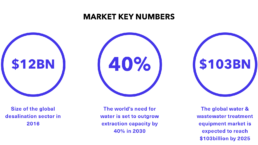In areas where freshwater resources are scarce, producing them might be the most viable option. New technologies can do this efficiently using renewable energy.
Developing new sources of fresh water can help to meet the needs of populations and industries in areas where traditional water sources cannot meet the growing demand. Although increased water efficiency and conservation can go a long way, existing freshwater resources cannot adequately meet demand in arid parts of the world in the long term (especially in large cities).

Treating wastewater for reuse is the most energy-efficient way of reclaiming water for consumption. However, advances in seawater desalination over the past decade have made this technology another viable source. Desalination plants can today produce fresh water at a cost of less than 2 USD/m3, meaning it would cost less than 10 US cents per day to provide one person with the WHO-recommended daily minimum of 49 liters of clean water. Currently, a major limitation of desalination is its high energy consumption, which is often supplied largely by fossil fuels. However, less energy-intensive plants are being developed, many of which are powered by renewable energy sources. Different approaches can be adopted simultaneously. For example, by 2050 countries in the Middle East and North Africa region are expected to meet 18 percent of their fresh water demand through increased efficiency gains, 14 percent through reuse of wastewater and 22 percent through solar-powered desalination.
In the longer run, new technologies like Ocean Thermal Energy Conversion (OTEC) could also become viable. OTEC generates electricity from thermal energy in the oceans and produces plenty of fresh water in the process. OTEC is untested on a large scale but is estimated to already be economically viable in island states if the fresh water produced is used. This promises a possible way around the so-called water-energy-(food) nexus, or the dilemma surrounding water and energy production wherein one often requires the other.
Survey Findings
Across regions the market opportunity Fresh Water Production is assessed as very positive for societies. Especially in Europe and North America, respondents have rated it optimistically for its potential positive impact on society. This assessment is echoed by respondents from the group of high-income economies as a whole.

Respondents from the governmental sector also believe this market will have a very positive impact on business. However they do not see it as an obvious area for new business ventures. The same pattern is evident looking across other sectors. Respondents from all business sectors as a group expect Fresh Water Production to have an impact on business, but it is not a market opportunity they see as likely to inspire new business ventures.

This market was surveyed globally in 2014 by more than 5500 leaders from both the public and private sectors. The survey was conducted in collaboration with the research company YouGov. The survey results were originally published in the Global Opportunity Report 2015.

